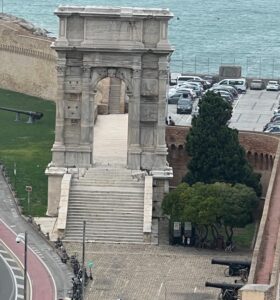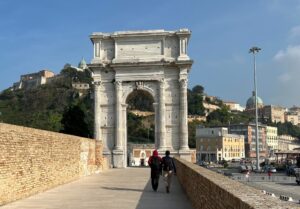Today we present a more unusual Mystery Photo. Give us the year and the background (the how and where) of this photograph, if you can. Send your details in to elliott@brack.net, and include your hometown.
 Yep, the last Mystery Photo was a tough one. First one in was Stew Ogilvie, Lawrenceville, who recognized The Arch of Trajan in Ancona, Italy. The photo came from Susan McBrayer of Sugar Hill.
Yep, the last Mystery Photo was a tough one. First one in was Stew Ogilvie, Lawrenceville, who recognized The Arch of Trajan in Ancona, Italy. The photo came from Susan McBrayer of Sugar Hill.
Lou Camerio of Lilburn, George Graf of Palmyra, Va., and Allan Peel of San Antonio, Tex. all chimed in with the right answers. Peel detailed: “One of the earliest and most celebrated arches to have survived from Roman times, the Trajan Arch, was built on the harbor at Ancona, Italy. It is a ‘Roman Triumphal Arch’ and was completed and dedicated in 115 AD. It was built to honor Emperor Trajan (ruled 98-117 AD), after he expanded the port of the city out of his own pocket, improving the docks and the fortifications.”
We also show another view of that arch.
Here is more information on the previous mystery photo, that of the Bona Allen mansion in Buford. As Bob Foreman of Grayson thought, that tile on the mansion indeed is Ludowici tile, named for the town in Georgia. The original owners of the tile factory, the Ludovisi family, were from Rome, Italy, and by the late 1800’s, had established a roof tile factory in Alfred, N.Y. in 1888, and called it Celadon Terra Cotta Co. In 1893, the Ludowici Roof Tile firm opened a plant in Chicago. By 1902 it purchased Imperial Brick in New Lexington, Ohio, and in 1904 it started a second manufacturing facility in Johnstown, Ga., which was later renamed Ludowici.
Tragedy hit in 1909, as both the New York and Chicago plants were destroyed by fire. In 1914, the Georgia plant was closed, and all operations moved to the Ohio facility. Later the company was sold to Certainteed, a division of Saint-Gobain. Meanwhile “Ludowici” terra cotta tile is on the Pennsylvania State Capitol Building; crowns buildings at the University of Colorado; the Plaza Hotel in New York; in 1927 on buildings at Duke University; and is seen on many buildings throughout the nation. The company says: “Since 1888, Ludowici has been protecting buildings large and small.”











Follow Us